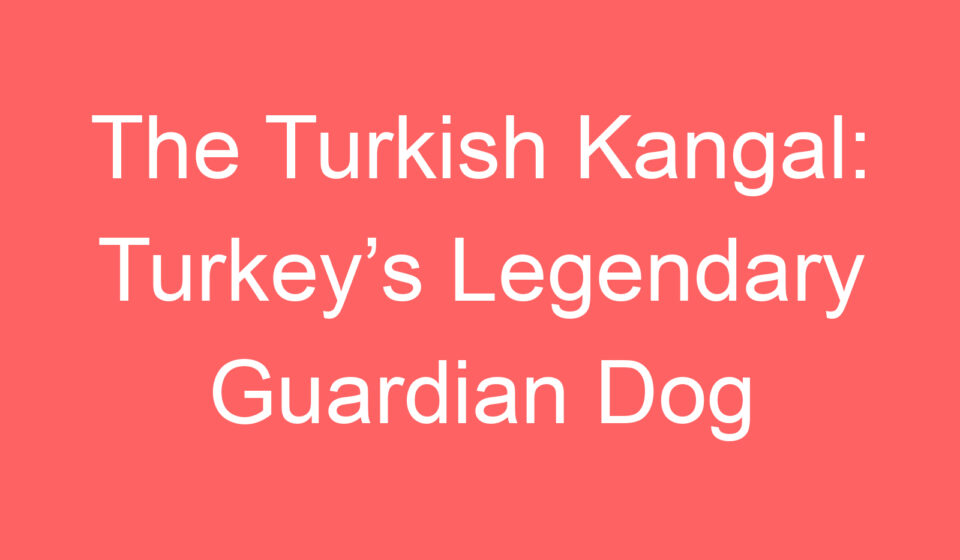
The Turkish Kangal: Turkey’s Legendary Guardian Dog
Introduction
When traveling through Turkey, especially in the vast landscapes of Anatolia, one animal you are likely to hear about is the Turkish Kangal. Known locally as the Kangal Shepherd Dog, this breed has long been regarded as one of the most powerful livestock guardians in the world. From rural farms to international documentaries, Kangals have built a reputation for their incredible strength, unmatched loyalty, and cultural significance. For tourists interested in Turkish heritage, meeting or learning about the Kangal provides a glimpse into the ancient bond between people and their animals in Anatolia.
Table Of Content
- Introduction
- What is a Turkish Kangal?
- Appearance and Size
- Lifespan and Health
- The Famous Bite Force
- Temperament and Behavior
- Kangals as Family Dogs
- Legends and Myths: Wolves and Lions
- Cost and Availability
- Are Kangals Legal in the USA?
- Training and Care Requirements
- Why Tourists Should Know About the Kangal
- Conclusion
- Related Posts
What is a Turkish Kangal?
The Turkish Kangal originates from Sivas Province in central Turkey, particularly the Kangal district, which gave the breed its name. For centuries, these dogs have worked side by side with shepherds, entrusted with the protection of sheep and goats against formidable predators like wolves, jackals, and even bears. Unlike herding breeds, Kangals do not move the flock; instead, they patrol, watch, and defend, making decisions on their own when danger appears.
In Turkey, they are considered a national treasure. The Kangal is not only a working dog but also a cultural icon, representing resilience, loyalty, and the deep traditions of pastoral life in Anatolia.
Appearance and Size
Encountering a Kangal for the first time can be breathtaking due to its size and presence. Tourists often describe them as regal yet intimidating. According to international standards:
- 📏 Height: 68–84 cm (27–33 inches) at the shoulder
- ⚖️ Weight: 40–68 kg (90–145 pounds)
- 💪 Build: Muscular and balanced, with a broad chest, thick neck, and strong bones
- 🐾 Coat: Short and dense, usually light tan or sable with a distinctive black facial mask
- 🌀 Tail: Long, carried curled over the back when alert
Their calm, confident posture conveys authority. When standing watch over a flock, they radiate both elegance and power.
Lifespan and Health
Kangals typically live 10 to 13 years, which is considered good for such a large breed. With proper care, balanced nutrition, and regular veterinary checkups, many live beyond this average. They are generally healthy but, like many big dogs, can be prone to hip dysplasia or joint problems if not exercised properly. Tourists who see them roaming Turkish highlands will notice their natural fitness, gained from active lifestyles.
The Famous Bite Force
Perhaps the most legendary claim about the Kangal is its bite strength. Popular reports suggest they can exert 700–743 PSI, often ranking them among the strongest bites in the canine world. While exact figures are debated and not all measurements are scientifically verified, what is certain is that Kangals are extremely powerful and capable of fending off dangerous predators. For many visitors, hearing shepherds speak proudly of their Kangals’ strength reinforces just how essential these dogs are to rural survival.
Temperament and Behavior
Despite their imposing appearance, Kangals are not naturally aggressive toward humans. They are known to be calm, steady, and intelligent. Their instincts make them excellent guardians, but also independent thinkers. This independence means they may not always obey commands blindly like other breeds, which can be surprising for those unfamiliar with livestock guardian dogs.
Kangals are deeply bonded with their families. In villages, they are often seen lying peacefully near children, yet springing into action the moment a threat appears. They are highly territorial, and strangers approaching flocks will quickly notice the Kangal’s vigilance.
Kangals as Family Dogs
For tourists who wonder whether such a guardian can also thrive in a home setting, the answer is yes—with the right environment:
- ❤️ Loyalty: They are affectionate and deeply loyal to their families.
- 🎓 Training: Early socialization and consistent training are vital. Without it, their protective instincts can become overwhelming.
- 🏡 Space: Kangals need large spaces or rural settings. A city apartment is not suitable.
- 🧑🤝🧑 Experience: They are best suited to experienced owners who can provide leadership and structure.
Meeting a well-trained Kangal in Turkey often surprises visitors—they discover a gentle, loving dog with those they trust, but always alert to protect.
Legends and Myths: Wolves and Lions
The Kangal’s reputation extends far beyond Turkey thanks to legendary tales:
- 🐺 Against wolves: Shepherds recount stories of Kangals chasing off wolves, sometimes even engaging in fierce battles to save the flock. Their bravery has cemented them as the ultimate sheepdog.
- 🦁 Against lions: Some myths go further, claiming that Kangals could fight and kill lions. While these stories are captivating, they are largely exaggerated. Lions are apex predators far beyond the realistic ability of any domestic dog.
Nevertheless, these legends add to the mystique, making the Kangal a subject of fascination for travelers and animal lovers alike.
Cost and Availability
For those enchanted by the breed, the question often arises: How much does a Kangal cost?
- 💵 Price range: $1,000–$4,000, depending on pedigree, breeder reputation, and health certifications.
- 🌍 Availability: In the United States and Europe, Kangals are rare. Most breeders focus on preserving working bloodlines rather than producing large numbers of puppies.
- 🇹🇷 In Turkey: Kangals are culturally protected. Exporting them has sometimes been restricted, as they are seen as part of the country’s heritage.
Tourists should keep in mind that owning such a breed requires not just money but also responsibility and proper facilities.
Are Kangals Legal in the USA?
Generally, Kangals are legal in most U.S. states. They are not typically listed under breed-specific bans like Pit Bulls or Rottweilers. However, local regulations may vary. Some cities may have restrictions regarding large guardian breeds or require owners to carry special insurance. Anyone considering bringing a Kangal to the U.S. should check local animal control laws before making plans.
Training and Care Requirements
For those curious about what it takes to raise a Kangal:
- 🏃 Exercise: Daily activity is essential. Long walks, free roaming in secure fields, or farm life suits them best.
- 🍖 Diet: High-quality, protein-rich food supports their muscular build.
- 🐕 Training: Firm but fair training helps channel their instincts. They respond best to calm, confident leadership.
- 🤝 Socialization: Introducing them early to children, guests, and other animals ensures they grow into well-adjusted companions.
Tourists will notice that many Turkish villagers let their Kangals roam freely, trusting them to guard both livestock and family homes without constant supervision.
Why Tourists Should Know About the Kangal
The Kangal is not just a dog—it is a cultural symbol of Turkey’s countryside. For visitors exploring Anatolia, spotting one patrolling a flock on the open plains is as iconic as seeing the region’s mosques or bazaars. Their presence speaks of centuries-old traditions where humans and animals worked together to survive in harsh conditions.
Learning about the Kangal allows tourists to better understand the values of strength, loyalty, and harmony with nature that run deep in Turkish culture. Some villages even celebrate the breed in local festivals, offering visitors a chance to see these guardians in action.
Conclusion
The Turkish Kangal is one of the most fascinating dog breeds in the world: a protector of flocks, a cherished national treasure, and the subject of enduring myths. Whether you meet one guarding sheep in the Anatolian highlands, hear stories from shepherds, or simply admire them from afar, the Kangal leaves a lasting impression. For tourists, learning about this legendary guardian adds a deeper layer of appreciation to the Turkish travel experience—reminding us that culture is not only in monuments and food but also in the living companions who walk beside people through history.

